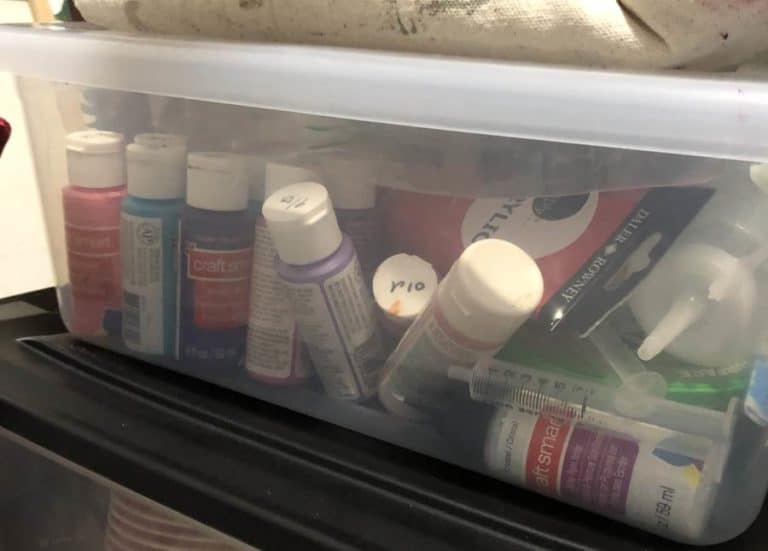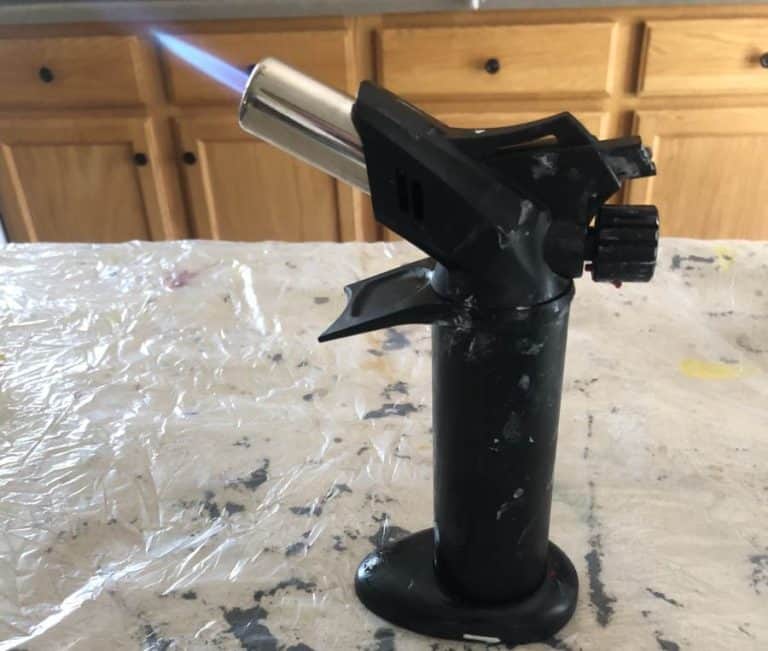What is Acrylic Pour Painting?
I am assuming that you have come to my site to figure out what all the fuss is about abstract pour painting. You keep seeing these beautiful flowy paintings on Pinterest, Instagram, and Facebook with all sorts of interesting color pallets and patterns. You have probably also realized that many of the “artist” doing acrylic pouring are just regular people having a really good time.
What is acrylic pour painting? Acrylic pour painting is a technique used to create paintings with natural flowing patterns. The effect is created by combining acrylic paint with a liquid medium. This mixture is then “poured” onto a surface and spread around by means of tilting the surface or manually manipulating the paint.
Acrylic painting has an interesting history and I hope you’ll read on to see what my research has taught me about the history and growing popularity of acrylic pour painting.

Where did Acrylic Pouring Come From?
Rise of Acrylics
Since the 15th century, oil paints and their derivatives have been one of the most common forms of paint. Famous artists like Vincent Van Gough and Leonardo da Vinci created their famous works The Starry Night and the Mona Lisa using oil paints.
Unfortunately, painting with oils is hard. It generally requires a great deal of skill, especially before the commercialization of painting materials. Oils also require more harsh chemicals as additives and cleaning solutions.
The popularity of art along with the difficulty of acquiring and using oil-based paints led the chemist and inventor Otto Röhm to create the first acrylic resin. By the 1940s acrylic paint was being used as a substitute for oil-based paints. These initial acrylics were also mineral-spirit based paints.
Fast forward a handful of years-the companies now associated with Golden and Liquitex created a water based acrylic solution. This solution initially became popularized in the house paint arena and was known as latex paints.
Latex house paints use less expensive binders like PVA (polyvinyl acetate) and vinyl to decrease the cost of producing the massive amounts of paints needed for residential and commercial use.
Artists and the manufacturers of art quality paints took note of the increasing popularity of acrylic/latex-based paints and modified them to produce what we now see in stores as acrylic artists paints.
“Accidental Painting”
According to an article by Brian Jacobsmeyer on Physics Central, in the 1930s, David Alfaro Siqueiros, a Mexican painter known for his beautiful frescoes, experimented with fluid paints.
During his experimentation, he poured a single black puddle of less viscous paint (aka “pour paint”) on a hard-flat painting surface. Then he poured a similar amount of a white liquid paint over the top of the black.
The white pain had a tendency to dip below the black, and the black appeared to bubble up through the white paint. This created a beautiful cloudy marbling effect. He described this new technique as his “accidental painting”.
Siqueiros was so fascinated by the interaction between the black and white paints that he hired a physicist to try and explain what was happening. He also wrote a number of letters to his girlfriend explaining his new obsession with drip and flow painting.
It is believed that David Alfaro Siqueiros was one of the artists who introduced Jackson Pollock to the drip and pour method of painting.
Science and Art Combined
Many years later, art historian Sandra Zetina, inspired by Siqueiros, also wanted to understand the fluid mechanics of paint. She paired with a fellow physics professor, Roberto Zenit, to conduct additional experiments on the subject.
When white paint was slowly poured on top of black paint, the white paint, being more dense than black paint, would fall through the black and settle on the bottom of the surface. If the white was poured on top of white, the same interaction did not happen.
Zetina and Zenit conducted their experimentation on transparent surfaces, so they could record the interaction of the paint from the top and bottom of the substrate.
It soon became apparent to the experimenters that the interactions of paint were a function of the densities of the paint. In physics, this interaction of materials of different densities is called Rayleigh-Taylor instability.
Additionally, while experimenting with the paint densities, Zetina and Zenit tested what happened between when the viscosity of paints were also changed. Viscous paint did not interact with less viscous paint as much in they way they naturally mix together when in close proximity. They also tend to move vertically less due to differences in density. Lookup the density of your acrylic paint with our Acrylic Paint Density Chart.
Fluid Acrylic Painting is Born
Most painters love to experiment. As with Siqueiros, Zetina, and Zenit, many other artists began to research how to use the new acrylic paints to created spectacular pieces. They discovered acrylics can be combined with all sorts of painting mediums to give them properties similar to oils and watercolors.
Flow acrylics, or pour acrylics, is one of the many new styles of painting that was seen coming out of the art world at the end of the 20th century
Acrylic Pouring’s Rising Popularity
Anyone Can Do It
I am the epitome of a left brained person. I enjoy mathematics and logic and I have worked in information technology my entire career. The most artistic thing I had been successful at prior to paint pouring, was the Etch-A-Sketch.
After seeing a few pour painting videos and pictures online, I was completely taken by the art of creating paint pours. This was an artistic pursuit at which someone like me could excel.
After a year of painting, I can say without a doubt that anyone can do it. There are a million things to learn, but to me that is the beauty of the whole experience: creating, modifying, throwing out, revising, and ultimately loving something that you were able to create with your own hands.
Relatively Inexpensive
With this rise of acrylics, came a logical segmentation of the acrylic paint qualities and offerings. Craft paints, student paints, and artist paints became the defacto nomenclature for the low, medium, and high-quality acrylic paints.
For beginners, craft paints are the perfect way to get your feet wet without breaking the bank. Add in a few 2-ounce bottles of paint, some filtered water, some cheap canvas board or scrap wood, add a place to paint, and you are well on your way to being an aspiring acrylic pour artist.
Shared Through Social Media
I believe the most important reason that fluid acrylic painting is so popular today is because of social media. Twenty years ago, you would have to have known an artist or go to a gallery or craft festival to see art.
Today, art is just a few clicks away. Instagram, Facebook, and YouTube are filled with artists sharing their works with the world. I first got interested in pour acrylics after watching a random video on YouTube. By the time I finished the first 7 minutes of a how-to video on acrylic pouring I was sold.
In the case of art, a picture really is worth a thousand words. One beautiful painting shared on social media at the right time and in the right place, can literally be seen by millions of people in a matter of days.
My challenge to you today is the take the leap and get started. I promise you it will open your eyes to a whole new world of possibilities. And I sincerely hope your life will be richer for it.
Related Questions
What supplies do you need for acrylic painting? Acrylic pouring can be done with as little as craft paints, water, and a painting surface. When you get a little more experienced, pouring mediums, higher quality paints, paint additives, and various paint surfaces can be utilized to create a wider variety of paintings.
Is oil or acrylic paint better for beginners? I would start with acrylics. For beginners, you want something that is easy, inexpensive, and relatively simple to clean up. In addition, many of the lessons you learn in acrylics carry over to oil painting.
Can you paint with acrylic on canvas? Canvases are an ideal to place to a paint with acrylics. Canvases have been used by acrylic artists since the day acrylics were first invented. They allow the water-based acrylics to dry through the canvas in addition to drying on the surface of the painting, which leads to more uniform drying, and a quicker drying and curing time.








I’m reading your Web site. It’s full of usefull information. Thank you for your structure and the quality of your knowledge.
You are very welcome. If you have questions that we haven’t answered, email us or comment on the offending article. Enjoy your pouring!
I love that you’ve included history and science on this site. I’m pretty left-brained myself, and this site is the most helpful resource I’ve found for learning about my new hobby.
Thank you. I appreciate that a lot. I find that a lot of artist just know how to do it and for beginners, and especially beginners that don’t feel like they are artistic, that just doesn’t help.
David,
After literally hundreds of hour viewing you tube videos and two years of participation, I am endeavoring to create my own videos. It’s a mixture of creating a large work environment and adequate video capture. I especially enjoy your approach of artistic science! I like the logic involved in step explanations as opposed to the accidental videos I have seen.
The scientific method is definitely my learning style. How things feel or seem doesn’t sit well with my brain. I know to know why and how to reproduce exactly every time.
Hi David i am a right brain person at 83 yrs old trying to do acrylic pouring , it has taken 6 months to become totally addicted .
thank you for the u tube feature on varnishing with a cloth first time my painting has looked good.
.dawn .
You are so welcome. I can’t tell you how frustrated at how hard getting a good finish was. I am glad my tutorial helped and hope the future articles and videos continue to do so!
Hi David i am a right brain person at 83 yrs old trying to do acrylic pouring , it has taken 6 months to become totally addicted .
thank you for the u t
I really enjoy the experimentation of art. However wonderful it is, I’m always worried its just beginners luck. Being able to understand the process and history is really helping my confidence grow.
What I love about your site is how you persent information in an uncomplicated and non elitist way.
Thank you x
Thanks so much for leaving this comment Heather. I do try to be as informative as possible without all the fluff.